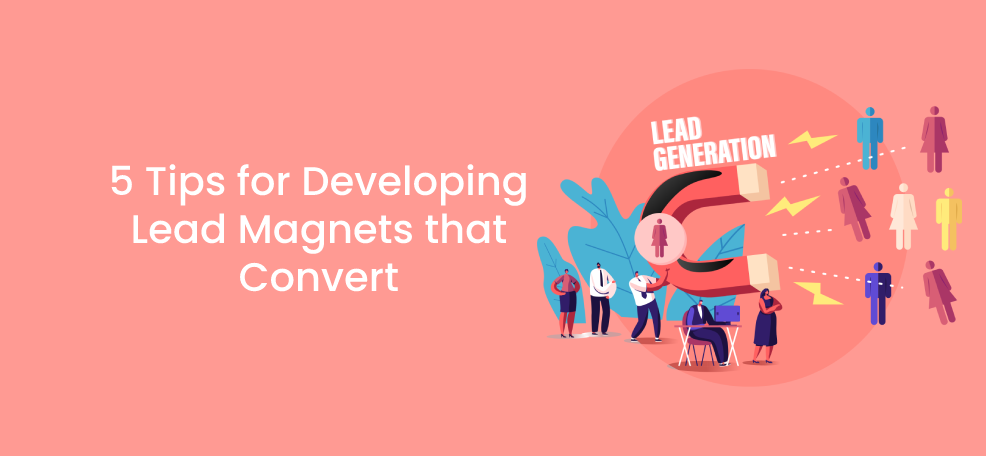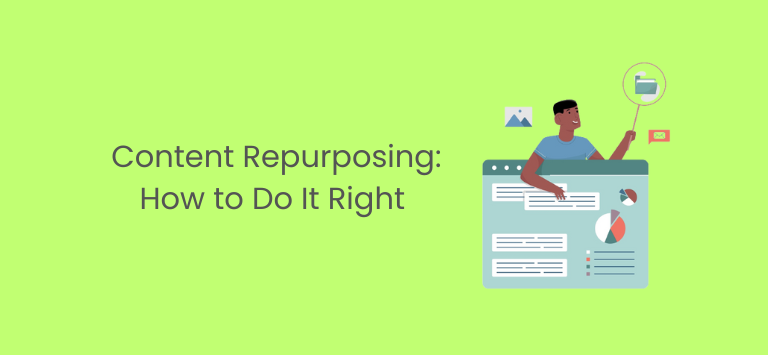Creating lead magnets for your website can be a very effective way to attract visitors and get them interested in your business. Many companies like using lead magnets because they give prospective customers an idea of how valuable your business can be and they help build trust in your audience.
They also allow you to take advantage of content marketing by giving you the opportunity to provide valuable resources in exchange for the contact information of potential customers.

What is a lead magnet?
If you’ve ever been on a website and had to input your contact details to get a valuable resource, then you probably have an idea of what lead magnets are. They’re free resources, items, or services that businesses give away in order to get people’s contact details.
Some common types of lead magnets include white papers, e-books, newsletters, trial periods, webinars, templates, case studies, or reports. Using any of these as a lead magnet is a great way to offer free value and channel more people into your sales funnel.
So, in this article, we are going to look at five different tactics you can use in developing a lead magnet that your website visitors will love.
Find out what your customers want
The most important thing when developing a lead magnet is that you make something your target customers actually want. If you create a lead magnet just for the sake of it, you may not get the results you’re looking for.
This means you need to figure out what your customers need, and one of the ways you can do this is by looking through common questions or comments that people send to your customer service team.
You could also conduct keyword research to find out what types of resources your customers are looking for. Start by using keywords and SEO research tools and then inputting relevant words or phrases that are common in your niche.
When you’ve done this, these tools will give you a list of relevant search queries that have been entered into search engines by the people in your target audience. Now that you have a list, you’ll be able to go through it, identify what your customers want, and take the necessary steps to provide valuable resources that will be of use to them.
Another way to work out what your audience would prefer as lead magnets are to send out a survey to your existing customers, and ask them to indicate what resources they would find most useful.
Once you’re able to figure out the best types of resources to use as lead magnets, you can then start to create relevant e-books, templates, or even free trial periods that will help you get the contact details of prospective customers.
Create a lead magnet that’s very relevant to your work
The whole point of creating a lead magnet is to attract your ideal customers. So, you want to ensure it’s relevant to your work to get the attention of people who are likely to be interested in your products or services.
For instance, if you are creating a lead magnet like an e-book or whitepaper, ensure the subject matter is relevant to your niche and the content itself can help solve pain points for your ideal audience.
Creating relevant lead magnets will also help to reduce your bounce rate. If you’re not familiar with the term, bounce rate refers to the percentage of people who leave your website quickly after only looking at one page. When they do this, it will send a message to search engines that your site isn’t particularly useful, which can have a detrimental effect on your SEO. So, you should make an effort to keep your rate low, and relevant lead magnets are great for that.
Now, to give you some inspiration, let’s study some examples of companies that do a great job of creating relevant lead magnets for their websites.

FreshBooks is a company that provides accounting software for small and medium-sized businesses. One of the solutions they offer is invoice generator software and what better way to get prospects interested in their business than by offering it to them for free?
On FreshBooks’ site, you’ll see that they give people the opportunity to create a free invoice, and the only information the company needs in return is the visitor’s email address. The prospect of getting a free invoice template is a very tempting one and most people would have no problem giving out their email addresses for this.
It’s also a very relevant lead magnet because it helps solve an accounting pain point for their audience. People who are interested in this resource could well be willing to invest in FreshBooks’ services either now or down the road.

On the other hand, Ping Identity draws people in and collects their contact details by offering a white paper on how SAML works. As a company that provides identity and access management solutions, this white paper is sure to be very helpful for their ideal customers, because SAML is the open standard language that enables their single sign-on solution.
However, people will need to enter their contact details if they want to receive this resource, and this helps the company to get more leads who can then be nurtured in their sales funnel. These two are excellent examples of how you can create relevant lead magnets for your website and it will serve you well to take inspiration from them.
Make sure your lead magnet addresses a real pain point
To make sure your lead magnet provides real value for your target audience, you want to ensure that it addresses a common pain point. This is one of the effective content marketing tips that can help you get the best possible results.
One of the ways you can ensure your lead magnets are addressing customer pain points is to find out about the exact problems your customers have. Earlier, we outlined how you can do this through keyword research and looking at the questions sent to your customer service team.
You could also join social media forums like Reddit or Quora and then look out for discussions around your niche. When you read through these discussions, you’ll find areas where people have issues and start to get ideas on how to create lead magnets that can solve those problems.
To give you some inspiration, let’s study how we do this over at Loganix.

One of the lead magnets that we offer on our website is a set of useful SEO templates and guides that can help our visitors with different marketing techniques. We’ve created templates to help with tasks like creating content briefs, planning content strategies, keyword research, or writing SEO contracts.
As a digital marketing agency, we know that a lot of people in our audience struggle with these tasks, so we’ve created customizable templates that can give them a head start and reduce the stress of starting from scratch every time.
Before creating a lead magnet for your audience, try to identify the pain points or problems they have so you can focus on using your resources to solve them.
Make sure your lead magnet is well-designed
If your lead magnet is poorly designed, it will look unprofessional and won’t get you the results you’re looking for. So, you’ll want to ensure that your lead magnet looks great, as well as provides value.
One thing you want to note is the importance of keeping it simple. You don’t need to use complicated designs for your lead magnets — you just need to use a simple and clean design that makes it easy to present your content in a professional manner.
You should also ensure that the design of your lead magnets reflects your branding so, whenever target customers use your tools, they’ll be reminded of your business. This can mean including your brand colors and logo in the design of your lead magnets.
If you need any help with this, you can always use visual tools to create professional designs for your lead magnets.
Create lead magnets for different stages of the buying journey
People at various stages of their buying journey will have different needs. So, you’ll want to create different lead magnets with this in mind.
There are three stages of the buying journey and they are awareness, consideration, and decision. Awareness is the first stage where potential customers get introduced to your brand and what you do. At this stage, you’ll want to provide educational content that highlights the problems of your target audience and shows how you can provide solutions for these pain points.
Let’s study an example of a website that does this well with its lead magnet.

Not all lead magnets have to be e-books or templates. Sometimes, an interactive element also works well. For instance, Looka is an online design platform that allows people to create logos for their brands, and they also have a free business name generator that works very well as a lead magnet for their site.
It’s particularly helpful for people at the beginning of their buyer journey as, if they don’t yet have a business name, they won’t quite be ready to design a logo, but this tool can help them get to that point, which is great for both Looka and their prospective clients.
Then we have the consideration stage, where the buyer has defined the problem and now begins to look through available options that can help solve the issue. The types of lead magnets you can create for this stage include templates, brochures, or free trials that can give prospective clients an idea of how you can help them.
And, to give you a practical example, here’s a website that has done a great job of creating a lead magnet for this stage.

Victoria University offers an online MBA program for students and, on the program page, you’ll find that they’ve included a contact form for people who would like to download a brochure and get more information.
The people at this stage of their buying journey are trying to pick the best program and school to enroll in, so this brochure acts as a good lead magnet because it provides more information, while also allowing the school to get the contact details of these prospects. This is a tactic you can also emulate for your business if you have a brochure or buyer’s guide for your services.
Finally, you have the decision stage where the buyer will choose the best option to suit their needs. The lead magnets that work at this stage are quite similar to that of the consideration stage. You could offer free trials, consultations, or even product demonstrations as lead magnets to give people an insight into the exact way your business can help them, so they’ll choose you over your competitors.
Analyse the effectiveness of your lead magnets
After you may have created your lead magnet for success, it’s important to track and measure the effectiveness of your lead magnets. It is possible that your lead magnet might not be addressing a major pain point in your customer’s journey and as a result producing fewer conversions. Analyse the pages on which your lead magnets are located on your website. Determine if those pages have a higher bounce rate than normal. Consider other factors that might come into play when determining bounce rate.
Summary
Getting a steady stream of leads for your business isn’t always the easiest thing to do. But creating and offering lead magnets will help you with this.
To get started, we’ve highlighted some tips that you can use. Here’s a recap:
- Find out what your customers want
- Create a lead magnet that’s very relevant to your work
- Make sure your lead magnet addresses a real pain point
- Ensure your lead magnet is well designed
- Create lead magnets for different stages of the buying journey
And, if you would like more business advice, make sure you follow Premio’s blog to stay updated on more tips and tricks you can use to get more leads and grow your brand.
Author’s Bio:
Aaron Haynes is CEO and co-founder of Loganix. The company is an SEO fulfillment partner for digital marketing agencies and professionals, which provides the services businesses need to improve their online visibility and grow. If you liked this article, check out the Loganix blog, where you’ll find more SEO guides full of expert advice.









